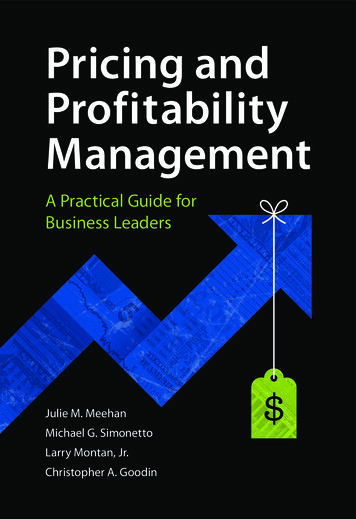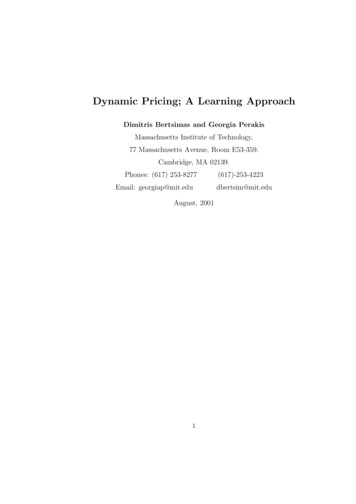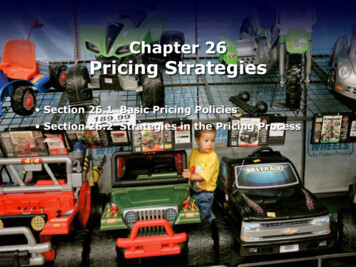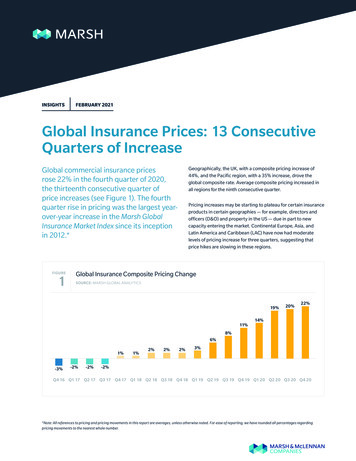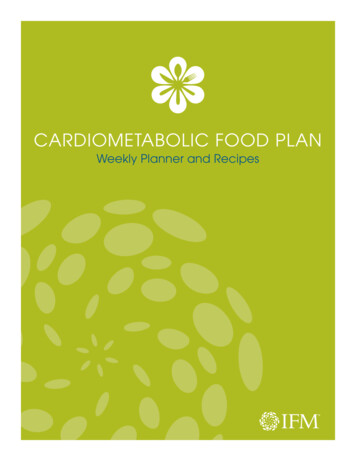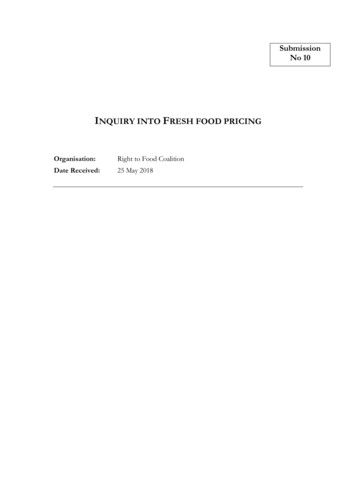
Transcription
SubmissionNo 10INQUIRY INTO FRESH FOOD PRICINGOrganisation:Right to Food CoalitionDate Received:25 May 2018
Submission from Right to Food CoalitiontoNSW Senate Enquiry into fresh food pricing. May 2018The Right to Food Coalition (RTFC) was formed in 2015 to advocate for food security for allAustralians and includes organisations, practitioners, researchers and community workersworking to address food injustice.Food security describes people's 'physical, social, and economic access to sufficient, safeand nutritious food to meet their dietary needs and food preferences for an active andhealthy life' (World Summit on Food Security 2009). As such, it is a fundamental issue ofequity and a major contributor to human wellbeing.We welcome the opportunity to make a submission to the NSW Parliamentary Enquiry intoFresh Food Pricing, and we are pleased to see that food insecurity is listed as a key topic forinvestigation, as we believe that this is often overlooked.We will address below some key issues for the RTFC included in the Terms of ReferenceExtent of food insecurity in NSW.It can be hard to determine accurately the extent of food insecurity anywhere in Australia,in the absence of routine, detailed and standardised collection of data.2014 figures from NSW Health (1) showed 6.9% people across NSW reported food insecurityin the previous 12 months. These figures are based on responses to the question ‘during thelast 12 months, have you run out of food and been unable to buy more?’However this figure as an averaged amount is almost meaningless. The HealthStats datashowed food security at 18.5% in the Aboriginal and Torres Strait Islander community, a 3%increase since 2012; those in lowest income quintile had 2-3 times the rate of foodinsecurity. Smaller-scale local surveys have uncovered even higher levels of food insecurityamong a number of at-risk groups; in Sydney, 40% of young peoplewho were homeless or atrisk of homelessness were found to have severe food insecurity (2); food insecurity affectedup to 86% of some newly-arrived refugee groups in Fairfield(3). A detailed survey in threedisadvantaged suburbs in SW Sydney found that 45% single parents experienced foodinsecurity. (4)The Rural Health Alliance report on food security in 2016(5) reported on high levels of FI inrural areas across Australia, revealing food insecurity in over 30% of Aboriginal and TorresStrait Islander people living in remote and very remote locations, compared with 20 percent of those living in major centres.1
‘Poor Health’, a 2016 *report from NCOSS on interviews with people on low incomes, foundthat 15% were unable to afford a balanced diet and 1 in 10 did not get a healthy meal eachday.While the average level of food insecurity in NSW has been relatively stable for about adecade, recent reports from FoodBank *and other charitable organisations show increasingdemand for service.Price and affordabilityIn the absence of routinely collected data, a number of health and welfare organisationshave tried to estimate the affordability of health foods for those on low incomes, through avariety of ‘healthy food baskets’. While these do not focus on cost of fruit and vegetablesalone, they can give an indication of the difficulties experienced by those with lowerincomes or in at risk groups in accessing fresh foods.In NSW, a 2007 Cancer Council* survey showed that people in lower income bands wouldneed to spend up to 56% of their income to purchase a healthy food basket.A more recent study in in Western NSW* (encompassing Murrimbidgee, Far Western NSWLHD, Hunter New England and Western NSW LHD), found that a basket of healthy food for afamily of four would require 34% of the Centrelink income support payment. Needing tospend over 30% of income on healthy food is considered to constitute ‘food stress’.- Upt to 48% )barosh and frielsoFamilies relying on Centrelink may need to spend up to 42 per cent of their income topurchase a basket of healthy food depending on where they live. Clearly, familiescan't afford to spend this much of their budget on foodFruit and vegetable prices can be particularly volatile, being susceptible to climate disasters,crop failuresA 2015 study *(ABS 2015a) found fruit and vegetable costs were rising faster than the CPIrateA Choice report revealed prices paid to wholesalers compared to retail costs and found thatfinal prices could be two –three times as much, with up to 76% of the final price going to theretailer. The* Curtin university study showed the biggest markup was for herbs andvegetables. Many farmers have reported the pressure from supermarkets, and complaindthat the cost of production can be higher than what they have been offered bysupermarkets.There is some evidence of the impact on both farmers and consumers of the concentrationof power in the retail sector in two main supermarket chains.Availability / food desertsThe research around food deserts is complex and sometimes contradictory. However anumber of surveys have shown the impact of availability of healthy foods on consumptionpatterns, suggesting that reduced access leads to poorer takeup of healthy foods.Fewer studies have been conducted in NSW than in some other states, notably Tasmaniaand Victoria, but some of their findings could be extrapolated to NSW: A recent *Tasmanianstudy found that while major supermarkets provided the least expensive healthy basketoverall, many LGAs had no major supermarkets, and only 5% of shops were located where30% Tasmanians lived.2
In addition, they found that found that people living in regions with limited or no access tofood shops are less likely to buy food consistent with healthy eating guidelinesIn W Australia, very remote residents were found to pay 26.1% more for the same basket asresidents of Perth.*Outback stores in W Australia, S Australia and the Northern Territory have been found toseel poor quality fruit and vegetables and out of date food items – there is no reason tosuspect the situation would be much different in NSW.Higher costs, combined with less access, expensive transport compound the effects of lowermedian incomes of people living in rural areas.A similar study in Victoria clearly demonstrated *Palermo – geographic inequalities inVictoria. Even in major metropolitan areas there is often poor transport in outer suburbs, sothat access to fresh food outlets may be limited, while proximity to fast food outlets hasbeen found to be 2.5 times higher in lower income areas.* In Western Sydney, Astell AsBurtMJA cited in No matter: in W Syudney 3:1 ration of takeaway shops to fresh food outletsA new phenomenon that has been noted is some urban areas is that new ‘effective’ fooddeserts can occur as local gentrification results in replacement of local general shops withgourmet and less affordable foodRecommendationsAdditional cost to the Tasmanian health care system resulting from food insecurityestimated conservatively at about 60 million per uearAdvocacy via COAG for systematic nutrition monitoring and surveillance to ensure that allpeople living in NSW are accessing healthy and nutritious foodAdvocate for no GST on fresh foodsSupport the work of INFORMAS to develop practical tools and methods for food price datacollection, analysis and reporting to inform economic and fiscal policy responses.Strategies to address FI have been focused on the individual end ie educational, budgetingand provision of emergency food relief, not on consolidating systems to plan for, monitorand have bqack up plans in case of problemsRespect, protect and fulfil rights UN charter1948(not legally binding) and 1989 conventionon the rights of the child.(is legally binding)Support for food hubs, farmers markets to enable farmers to trade directly with the publicand reduce food milesGrowers under pressure because of prices, land availability etcNeed to develop strategies to ensure good supply of affordable fresh foods to all people.This could include subsidies for transport to remote regions;Consider measures to ensure stability of availability of affordable fruit and vegetablesSubsidies for agriculture and /or transport; vouchers for people on low incomes.Local and resilient food systems – keeping money in local economies, supporting localregional development3
Already lost high percentage of quality ag land close to cities through urban expansion anddevelopment pressures, undermining the local and resilient food supply.% of frsh. Dana’s scenario/ foodsheeds and steps that could be taken to support itNeed to be done in broader context of national policy (see NRHA paper) with state and localpolicyNeed to recognise whole food system – policy all along, welfare considertions,It has been suggested that Australia does not produce enough fruit and vegetables to meetthe dietary guidelinesBy 2011, 23 countreis ha duplicity Incorp RTF into their constitutiondandn 33 motrerecognised RTF as part of broader HR guarantees. NOT AustraliaFood as necessity or commodityHealth education approach insufficientNeed changes to :Local profilesTown planning inc transport and outletsImprove local food systems – support local regional businesses, grantsCentrelink to match needsNational food plans to integrate envtl ag, social and nutrition systmsEFR not a solution need dignity, access to healthy and affordable food – not leftovers fromdysfunctional syste,Comp food policy including farmers, ensure food produced linked to national food strategy.NFP and ACWP both focus on food as commodity for profit and exportLocal councils in Victoria coming up with holistic food system policies- acknowledge Hr tofood- devt of multifunctional food hubs taking from charity to empowermentTas (Murray) has widespread food deserts – result of market forces, lack of planningBibliographyHealthS Submission from Right to Food Coalition to Senate Enquiry into fresh food pricingMay 2018The Right to Food Coalition (RTFC) was formed in 2015 to advocate for food security for allAustralians and includes organisations, practitioners, researchers and community workersworking to address food injustice.Food security describes people's 'physical, social, and economic access to sufficient, safeand nutritious food to meet their dietary needs and food preferences for an active andhealthy life' (World Summit on Food Security 2009). As such, it is a fundamental issue ofequity and a major contributor to human wellbeing.4
We welcome the opportunity to make a submission to the NSW Parliamentary Enquiry intoFresh Food Pricing, and we are pleased to see that food insecurity is listed as a key topic forinvestigation, as we believe that this is often overlooked.We will address below some key issues for the RTFC included in the Terms of ReferenceExtent of food insecurity in NSW.It can be hard to determine accurately the extent of food insecurity anywhere in Australia,in the absence of routine, detailed and standardised collection of data.2014 figures from NSW Health *showed 6.9% people across NSW reported food insecurityin the previous 12 months. These figures are based on responses to the question ‘during thelast 12 months, have you run out of food and been unable to buy more?’However this figure as an averaged amount is almost meaningless. NSW HealthStats data(2015) showed food security at 18.5% in the Aboriginal and Torres Strait Islandercommunity, a 3% increase since 2012; those in lowest income quintile had 2-3 times therate of food insecurity. Smaller-scale local surveys have uncovered even higher levels offood insecurity among a number of at-risk groups; in Sydney, 40% of young people* whowere homeless or at risk of homelessness were found to have severe food insecurity; foodinsecurity affected up to 86% of some newly-arrived refugee groups in Fairfield.* A detailedsurvey in three disadvantaged suburbs in SW Sydney found that 45% single parentsexperienced food insecurity. *The Rural Health Alliance report on food security in 2016* reported on high levels of FI inrural areas across Australia, revealing food insecurity in over 30% of Aboriginal and TorresStrait Islander people living in remote and very remote locations, compared with 20 percent of those living in major centres.‘Poor Health’, a 2016 *report from NCOSS on interviews with people on low incomes, foundthat 15% were unable to afford a balanced diet and 1 in 10 did not get a healthy meal eachday.While the average level of food insecurity in NSW has been relatively stable for about adecade, recent reports from FoodBank *and other charitable organisations show increasingdemand for service.Price and affordabilityIn the absence of routinely collected data, a number of health and welfare organisationshave tried to estimate the affordability of health foods for those on low incomes, through avariety of ‘healthy food baskets’. While these do not focus on cost of fruit and vegetablesalone, they can give an indication of the difficulties experienced by those with lowerincomes or in at risk groups in accessing fresh foods.In NSW, a 2007 Cancer Council(8) survey showed that people in lower income bands wouldneed to spend up to 56% of their income to purchase a healthy food basket.A more recent study in in Western NSW(9) (encompassing Murrimbidgee, Far Western NSWLHD, Hunter New England and Western NSW LHD), found that a basket of healthy food for afamily of four would require 34% of the Centrelink income support payment. Needing tospend over 30% of income on healthy food is considered to constitute ‘food stress’.5
A Choice report cited in the Sydney Morning Herald revealed prices paid to wholesalerscompared to retail costs and found that final prices could be two –three times as much, withup to 76% of the final price going to the retailer. The biggest markup was for herbs andvegetables. Many farmers have reported the pressure from supermarkets, and complainedthat the cost of production can be higher than what they have been offered bysupermarkets.There is some evidence of the impact on both farmers and consumers of the concentrationof power in the retail sector in two main supermarket chains.Availability / food desertsThe research around food deserts is complex and sometimes contradictory. However anumber of surveys have shown the impact of availability of healthy foods on consumptionpatterns, suggesting that reduced access leads to poorer takeup of healthy foods.Fewer studies have been conducted in NSW than in some other states, notably Tasmaniaand Victoria, but some of their findings could be extrapolated to NSW: A recent Tasmanianstudy (11) found that while major supermarkets provided the least expensive healthy basketoverall, many LGAs had no major supermarkets, and only 5% of shops were located where30% Tasmanians lived.In addition, they found that found that people living in regions with limited or no access tofood shops are less likely to buy food consistent with healthy eating guidelines.In W Australia, very remote residents were found to pay 26.1% more for the same basket asresidents of Perth(12)Outback stores in W Australia, S Australia and the Northern Territory have been found toseel poor quality fruit and vegetables and out of date food items (13) – there is no reason tosuspect the situation would be much different in NSW.Higher costs, combined with less access, expensive transport compound the effects of lowermedian incomes of people living in rural areas.A similar study in Victoria clearly demonstrated geographic inequalities in Victoria (14).Even in major metropolitan areas there is often poor transport in outer suburbs, so thataccess to fresh food outlets may be limited, while proximity to fast food outlets has beenfound to be 2.5 times higher in lower income areas.(15) In Western Sydney, Astell-Burtfound a 3:1 ration of takeaway shops to fresh food outlets. (16)A new phenomenon that has been noted is some urban areas is that new ‘effective’ fooddeserts can occur as local gentrification results in replacement of local general shops withgourmet and less affordable foodRecommendationsFood insecurity is very costly. The additional cost to the Tasmanian health care systemresulting from food insecurity has been estimated conservatively at about 60 million peryear.6
The RTF recommends that the NSW government advocates via COAG to ensureminimisation of food insecurity through in NSW and across Australia by : Systematic nutrition monitoring and surveillance to ensure that all people living inNSW are accessing healthy and nutritious food Advocate for no change to impose a GST on fresh foods, which would render themeven less affordable for those most in need of healthy and fresh foods Supporting the work of INFORMAS to develop practical tools and methods for foodprice data collection, analysis and reporting to inform economic and fiscal policyresponses. Address food insecurity as a systemic issue which is the responsibility ofgovernments and not of individual behaviours Advocate for an increase in welfare payments such as Newstart to enable recipientsto afford access to healthy food Advocacy for better and more integrated planning in future, recognising the humanright to food and the cost (to the individual and to the economy) of not ensuring fairand equitable access to fresh food. Development of a comprehensive food policy including farmers, to ensure foodproduced is linked to a national food strategy.In NSW, RTF recommends the following strategies: Support for development of food hubs and farmers markets, to enable farmers totrade directly with the public. Such strategies could also help to boost regionalbusinesses and employment and reduce food miles Quarantine agricultural land close to cities to enable continued production of freshfruit and vegetables within easy reach of labour markets and consumers. Consider subsidies to support affordability of fresh foods in rural and remote areas.This could take the form of agricultural or transport subsidies or vouchers for thosein low income areas in case of extremeBibliography(1) NSW HealthStats. (2015) Food Insecurity 2014. Accesile viahttp://www.healthstats.nsw.gov.au/Indicator/beh foodsec age/beh foodsec age(2) YHunger ams/yhunger.aspx(3) Feeding the family in an unfamiliar environment Southcombe et al(4) ours(5) National Rural Health Alliance. (2016). Food Security and Health in Rural andRemote Australia. Rural Industries Research and Development Corporation. Availablevia ublications/16-053.pdf(6) NCOSS. Poor Health: The Cost of Living in NSW.2016(7) Food Bank. End Hunger report 2017.(8) Cancer Council NSW 2008. Healthy Food Basket Survey.(9) Priestly J, Charles Sturt University. Tackling Food Insecurity: Getting Healthy Foodon the Table. 20167
https://www.csu.edu.au/ data/assets/pdf an Healthy Food Access Basket Report et-study.pdf(11)Xx(12)Xx(13)Xx(14)Palermo et al(15)Burns et(16)Astell Burt T & Feng X . Geographic inequity in healthy food environment andtype 2 diabetes. Medical Journal of Australia 21 September 20158
that 15% were unable to afford a balanced diet and 1 in 10 did not get a healthy meal each day. While the average level of food insecurity in NSW has been relatively stable for about a decade, recent reports from FoodBank *and other charitable organisations show increasing demand for service. Price and affordability

